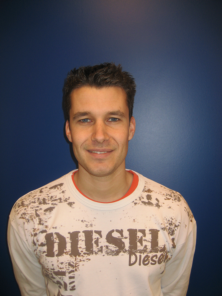AC electro-osmosis in nanochannels
Promotion date: 2. April 2009
Promotor: Prof dr. ir. Albert van den Berg
Assistant promotor: Dr. Jan C.T. Eijkel
| AC electro-osmosis (AC-EO) is the movement of liquid induced by the application of alternating current potential waves to wall-integrated electrodes. Asymmetry is added either in space (by electrode geometry) of in time (by applying asymmetric AC signals). This thesis was part of the NanoNed PhD project: “Flow sensing and control in nanochannels”. In nanochannels new applications appear and deviated behaviour is observed, as electrokinetics scale favourably with decreasing channel dimensions which are, as a second reason for deviated behavior, more close to the Debye length. During fabrication a method to galvanically enhance the etch rate of the nanochannels was explored. The device behaviour and experimental results were modelled using finite element methods. The model indeed predicted complex, but interesting, device behaviour. Fabricating homemade PDMS disposable connectors, better integrated the experimental (nano-/micro-) setup to the rest of the experimental setup. |
Is it hard to use electro-osmosis at the nano-scale level?
To integrate the electrodes in the wall of the channel, was a tough challenge. With the help of cleanroom specialist, Johan Bomer, we succeeded to overcome the problems involved. A method using gold electrodes appeared to be a relatively fast and reliable way of producing.
Another challenge was to produce a device that could hold out experiments for a day or longer. Instead of using a standard holder, I designed a specific interface to link the nano-channels to the micro- and larger sized device elements.
Do surprising phenoma play a role at these small levels?
Current methods to measure the movement of the liquid often don’t work anymore. Methods using for example fluorescent beads don’t work because the beads get stuck in and block the channel. Using fluorescent molecules is problematic as well. They either stick to the wall much more dominantly than in larger, micro-sized, channels or get excluded from the channels.
At the end, electric measurement using conductivity changes, on purpose induced in the channels, proved to be a good solution. Some outcomes were surprising, most likely because the size of the channels is near the Debye length.
What are your future plans?
The next three years I will be working on a post-doc project at the BIOS, the lab-on-a chip group. Fluidic systems form an integral part of pill-like devices, with which non-invasive early diagnosis of intestinal cancer is possible. Within Twente University quite a number of researches study aspects of this method.
What strong points MESA+ should keep doing in the future, in your opinion?
Of course, MESA+ is an interdisciplinary institution because at the nano-scale level a lot of features, physical phenomena and production methods come together. As I compared my way of working with other thesis students at different universities, I found out I was very lucky working at MESA+. The cleanroom facilities are very good, so you don’t have to wait for a long time and with expert help it is possible to fine-tune your chip-devices, if necessary, at all stages of the project.
Do you think your research will have some follow-up at MESA+?
I hope so, off course. Extra experiments will bring a more reliable insight in the way the device works. Furthermore, the topic of fluid movements at this small scale, is of fundamental interest.
And also I think it is possible to think out principles to separate and/or manipulate bio-molecules, using these nanochannels. Introduction of such molecules to these nanochannels will likely result in interesting behaviour.

